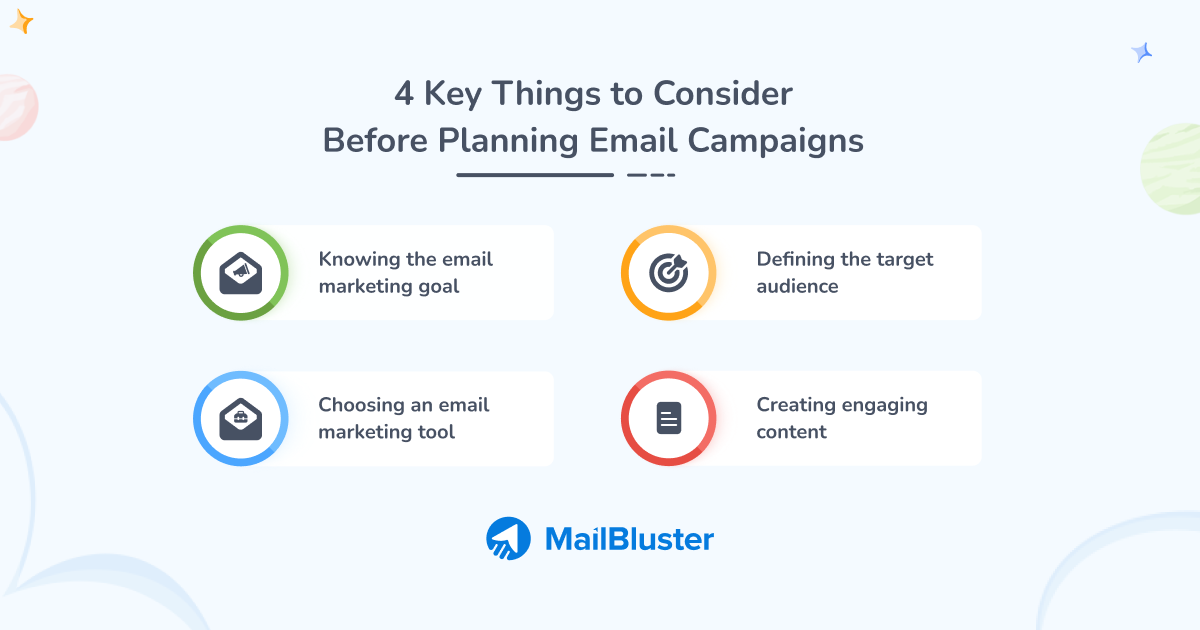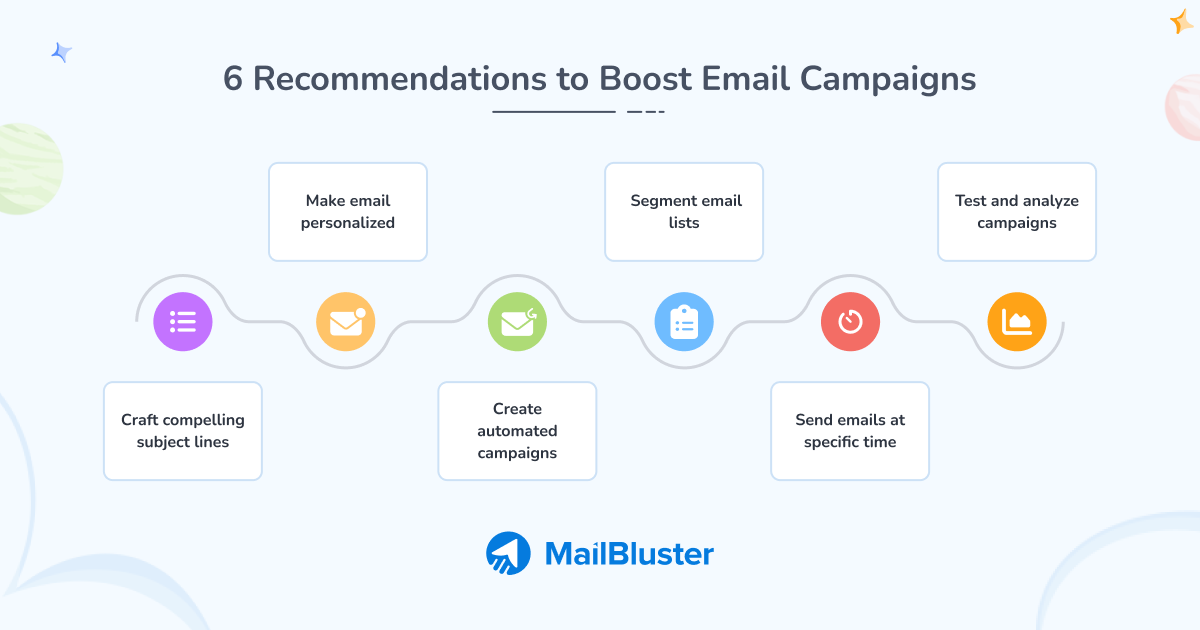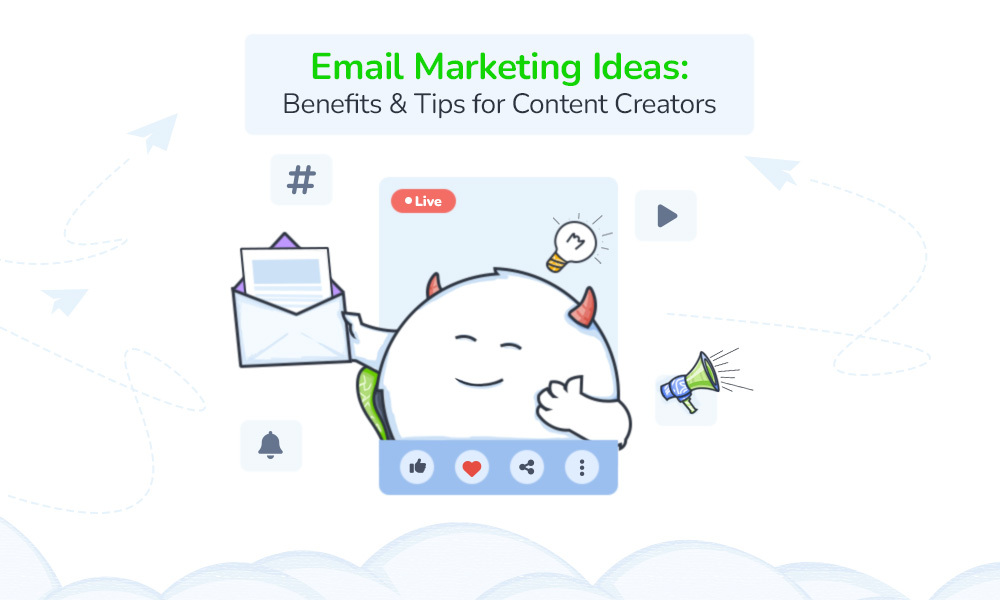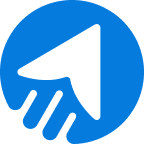Email marketing is one of the most effective forms of digital marketing, and it leads to the growth of email marketing ideas. Marketers prefer this marketing strategy more than any other form of marketing.
Statistics show that email marketing continues to increase its revenue to 18.9 billion U.S. dollars.
Impressive enough, right? But before starting email marketing, you must leverage proper email marketing ideas. This article will share the tricks to run successful email marketing campaigns for content creators. As a content creator, you should always be ahead with the right strategies.
So, why wait? Let’s dive into the full article. ✨
Table of contents
- How does email marketing benefit content creators?
- What to do before planning email campaigns
- 7 email marketing ideas to elevate branding
- Recommendations to boost your email campaigns
- Conclusion
How does email marketing benefit content creators?
Data tells it all. For every $1 spent on email marketing, marketers receive an average return of $42. So, email marketing is essential for content creators as it offers more, such as:
- Higher conversion rates: Email marketing has the highest conversion rates among other channels, as it delivers a 36x ROI. So, if you want to get higher conversion rates, email marketing can be a savior.
- Increased brand awareness: Consistent email communication helps you build strong brand awareness. If you are sending regular emails, your brand will be on the audience’s minds.
- Stronger relationships with clients: Email allows for personal interaction. It fosters a sense of community and trust with your clients.
- Better open rates & click-to-open rate: Personalized email campaigns increase open rates by 26%. This will result in better open and click-to-open rates if you run customized email campaigns for particular audiences.
- Cost-effective marketing: Email marketing is an affordable solution for digital creators and markets. So, if you are looking for a budget-friendly option, emails are your channel!
What to do before planning email campaigns
Before starting your email campaign, you have to follow a few factors. These are our suggestions before launching your first email campaign as a content creator:

Know your email marketing goal
The goal is the key in every sector. Without a clear and definite goal, you won’t get the expected return. However, goals can vary from business to business. It can be either selling your product, building brand awareness, or returning inactive subscribers.
Also, some campaigns might target to collect more information from email lists. Here, marketers use different email campaign ideas to target the audience. Even the goal might be just to stay top-of-mind of the subscribers. Clearly recognize what your goals are.
Define your target audience
Understanding your audience’s demographics, interests, and pain points is always important. Knowing your audience is essential to creating and sending relevant and engaging content, as the target audience plays a significant role in email marketing. Marketers create email lists according to the target audience.
Choose an email marketing platform
There are many email marketing platforms available out there. You can explore email marketing platforms like MailBluster. This powerful and affordable email marketing tool is a preferred choice among marketers. Its reasonable pricing structure also provides personalized email sending, email automation, A/B testing, segmentation, drag & drop editor, double opt-in, real-time tracking features, and more. Moreover, you can use many pre-built email templates from MailBluster’s template gallery to enhance your email marketing approach.
At the same time, as a content creator, if you are looking for a platform to create and sell online courses, you can check EzyCourse. It’s an online course builder tool that helps you create engaging courses without having any technical or design knowledge. It also offers many other marketing features to facilitate and elevate your course sales.
Create engaging content
You may already know that most people will leave your email within a few seconds. Within these few seconds, you have to hold the interest of your audience. So, an attractive content is a must. And you should do that well being a content creator! Remember, personalization is the king here. Edit your email’s subject line, header, and preheader, and use the drag-and-drop editor feature to create engaging content seamlessly.
Your email content should be insightful and relevant to the reader. Don’t forget to offer –
- Exclusive content not found on your website
- Insider tips and advice
- Free guides and templates
- Behind-the-scenes insights
- Q&As and polls
💡 Bonus Tip: Track the results
You have to track the results of your email campaigns. There are several metrics to track email campaigns. Check the eight email marketing metrics to track the result:
- Open rate
- Clickthrough rate (CTR)
- Clicks per link
- Bounce rate
- Unsubscribes
- Spam complaints
- Conversion rate
- Return on investment (ROI)
MailBluster includes email campaign analytics to track the campaign results. The analytics include open rate, CTR, bounce rate, unsubscribe rate, click rate, delivery rate, and more.
7 email marketing ideas to elevate branding
Your brand, your voice. With the right email marketing tricks, you can grab your customers’ attention. Do you know what makes an email click? And what brings people more to your brand? We’ve got some suggestions for you. Here, we will tell you the top seven email marketing ideas to achieve great results in your email marketing. Let’s explore these strategies to reach your audience, drive engagement, and elevate your brand.
1Newsletter
73% of B2B marketers say email newsletters deliver the best results as a distribution channel. Newsletters offer a consistent way to deliver valuable content. It is a great way to grow your business and convert leads. Therefore, regularly send content or new website updates to your valuable subscribers. Also, you can send content such as:
- New articles: It’s a good idea to share and let your subscribers know about your newly posted articles. This way, you keep your subscribers alive.
- Blog updates: If there’s a news or story to share, blog changes appear, let your subscribers know about it.
- Recent product updates: if you have an e-commerce business, whether pricing or product changes, promote it to your subscribers.
- Behind-the-scenes stories: when you handle a popular business, people want to know how do you handle it. Share possible behind-the-scenario with the subscribers to let them know more!
- Upcoming events: Post upcoming events, posts, and images for your subscribers to let them know about what’s coming up next!
💡 Tips: A newsletter should be right on the money. Structure your newsletter to get better results. Focus on a few things, like:
- Keep clear sections
- Include a featured section
- Show recent updates
- Give a strong call-to-action button
- Highlight social media channels.
2Welcome email
First impressions matter! Welcome emails help you create trust and build a strong relationship with your subscribers. However, more than just another single welcome email may be needed to set the stage. So, try to make a positive first impression with a fine welcome email. The marketing idea is your chance to:
- Introduce your brand and its values
- Show gratitude for subscribing
- Give a glimpse into the content they will get
- Offer giveaway/exclusive content as a welcome gift
💡 Tips: Make your welcome emails engaging, personalized, and relevant to your audience. Always make your email more personalized to earn your customers’ attention.
3Announcement email
Always keep your audience posted. How do your subscribers know that you brought something special for them? An announcement will notify your users about new courses, products, services, or exciting updates. It will be an excellent idea for email marketing to grow your brand.
Have you ever thought that there can be several types of email announcements? Below are some kinds of announcement emails highlighted. You can use these ideas in your email marketing campaigns to increase conversions and sales.
Product & Service related announcements:
- New product/Feature launch: You can share the announcement email with your existing and potential customers about a brand new product or exciting new feature.
- Product update: Product update emails inform the users about improvements, bug fixes, or changes to an existing product.
- Product discontinuation: You can let your customers know that a product will no longer be available and offer alternatives if you can.
- Changes in pricing: Inform users about upcoming price adjustments and explain the reasons behind them.
- Special offers & promotions: You’ve got a great way to highlight limited-time discounts, bundles, or exclusive deals through an announcement email.
Brand related announcements:
- Company updates & milestones: Share important company updates, achievements, awards, or partnerships.
- Events & webinars: If your brand is going to launch any event or webinars in the upcoming future, then let them know the news through email. Invite recipients to attend online or in-person events hosted by the company.
Customer Service & Support:
Service disruptions and security updates: You can announce service disruptions to keep your customers tension-free. Also, inform them about potential security threats or vulnerabilities and recommend actions to take.
Other:
- Seasonal greetings: Greeting emails can be a helpful trick to hold customers’s interest in your brand! You can send holiday wishes or special messages for occasions like birthdays or anniversaries.
- Surveys & feedback requests: Asking for customer feedback can help you improve products or services.
Always keep in mind that an announcement email should be clear, concise, and relevant to the customer.
4Personal branding email
Email is a great platform to help you build trust and authenticity. Personal branding emails can connect with your audience on a deeper level. It’ll be an excellent way to share your brand-related personal anecdotes and behind-the-scenes stories or offer advice related to your niche. This way, your audience will know more about your brand, and your trustworthiness will also multiply. That’s the reason personal branding brings success for content creators.
We noted some personal branding email marketing ideas to help you build your audience. Read them carefully:
- Case studies & success stories: Highlight case studies and accomplishments of your brand expertise. You can share real-world examples of how you’ve helped others.
- “Ask Me Anything” (AMA) sessions: Invite your subscribers to submit questions and answer them in a dedicated email or live Q&A session.
- Exclusive content for subscribers: It can be an engaging strategy to hook your potential customers. You can offer ebooks, checklists, templates, or other exclusive resources.
- Contests & Giveaways: Occasional contests or giveaways can make your brand a place of interest. You can generate excitement and reward your customers.
- Behind-the-scenes stories: Personal story! Sounds wrong? Should a company share its personal stories? However, think more deeply. If you start sharing the glimpses and the background scenes of your brand, it will humanize your brand.
- Collaboration with influencers: In your email content, you can feature other industry experts or influencers to expand your reach and build relationships.
- Testimonials and spotlights: Testimonial emails work like magic. Sending a testimonial email to long-term clients, using testimonial advertising for potential buyers, or citing reviews left by other customers after purchasing products or ordering services is a great way to get positive feedback from satisfied clients and build trust and credibility.
Thus, you can smoothly build your personal brand by utilizing these email marketing ideas.
5Feedback request email
Feedback is a gift for your brand. If you can actively seek out feedback, it will help you improve. Plus, you can establish stronger relationships with your customers and create a better experience for everyone.
Here are a few feedback request email ideas that can help you. For example, you can ask for feedback like:
- Post-Purchase/Service: Subject example: We Value Your Feedback!
- After a Webinar/Event: Subject example: Share Your Thoughts on [Webinar/Event Name]
- General Satisfaction Check-In: Subject example: How Are We Doing?
- Product/Feature Feedback: Subject example: Your Thoughts on [New Feature/Product]?
- Website/User Experience Feedback: Subject example: Help Us Improve Our Website
- Customer Service Feedback: Subject example: We Care About Your Experience
💡 Tips for Effective Feedback Requests: While you are allowing feedback from your customers, keep these factors in mind-
- Keep it concise and clear
- Make it easy to respond
- Consider offering a small reward (optional)
- Thank respondents for their time and feedback
- Act on the feedback
6Seasonal marketing campaigns
A seasonal marketing campaign is a targeted and time-limited promotion. It will help you increase sales by utilizing the right marketing strategies. Seasonal marketing is also called holiday marketing. That means you will try to connect with your audience during specific times/ occasions of the year.
The seasonal email campaign idea can:
- Create a sense of urgency among your audience
- Offer themed content, exclusive promotions, or festive greetings relevant to the season
- Drive more sales during several periods of the year
💡 Special Tips for Seasonal Email Marketing Campaigns: While you are planning to run seasonal campaigns, consider the right content ideas. For example, you can provide:
- Holiday-specific promotions and discounts, gift guides, and themed bundles.
- Giveaways and prizes to engage your audience and generate excitement.
- User-generated content to motivate customers to share their experiences with your products
The seasonal email template can be used to send promotional emails such as gifting, discounts, or greetings. Use MailBluster’s email sender feature to create or insert your preferred template to start your promotion.
7Drip campaigns
Drip campaigns are an automated marketing tactic that involves sending a series of time-based automated emails. Let’s see what drip campaign emails can contain:
- Welcome emails: Welcoming new subscribers can be a starter pack! Also, you can offer them a coupon code or discount so that they can use it for their next purchase.
- Onboarding emails: By sending onboarding emails, you can introduce your products to the customers.
- Abandoned cart emails: Send emails to the customers who left their cart while purchasing.
- Product recommendations: Recommend products based on your customer’s data and previous purchases.
💡 Tips to Manage Your Drip Campaign: There are a few tricks to run your drip campaign successfully. For example:
- Pick the right trigger
- Find out your audience’s interest
- Craft messages for particular emails
- Track emails and adjust based on output
- Review and maintain all your drip campaigns periodically
Although running drip campaigns might look daunting at first, use any assistance to help you out in this situation. To get more productive outcomes from drip campaigns, use the email automation feature of MailBluster.
Recommendations to boost your email campaigns

You must be looking for results, right? To increase sales by email marketing, you must choose an email marketing tool. For instance, MailBluster can be your best companion, which can help you boost and create the perfect email campaign with analytics. Also, below are a few more email marketing ideas and best practices for content creators.
First of all, always focus on the people who are most likely to convert. More importantly, craft your email campaigns with exciting subject lines so that your email can attract people to read. Let’s look at strategies to maximize your email campaign’s impact.
Crafting subject lines
How long a subject line should be? Research suggests subject lines should be less than 50 characters. It helps you with 12% higher open rates and 75% higher click-through rates (CTR) than longer subject lines.
Hence, your subject line is crucial for getting your emails opened. Making email subject lines catchy is not rocket science. Here are a few essential tips for you:
- Keep it concise, specific, and meaningful
- Use numbers and emojis appropriately
- Create a sense of curiosity
- Make it personalized when applicable
- Avoid adding Spammy words
- A/B Test different subject lines
Make your email personalized
Personalized email marketing is a key factor in letting your users feel more relevant and engaging. The growth of email marketing is broadly dependent on email personalization. So, marketers should maintain personalization strategies. Hence, you may try these strategies:
- Use the recipient’s name to feel engaged
- Segment your list based on demographics, interests, or past interactions to deliver relevant content
- Offer personalized recommendations by leveraging purchase data to suggest products or services
Create automated campaigns
Automation makes email marketing more efficient. But make sure you choose the right trigger to increase revenue 24 times compared to typical emails.
By creating automated campaigns, you can enhance customer engagement. Automated emails can help you deliver personalized messages based on user behavior and interactions. For example, welcome emails can be triggered when a new subscriber signs up. Onboarding emails can introduce new customers to your brand. Moreover, automated product recommendations can suggest items based on previous purchases.
Segmenting emails
Segmenting your email list helps you to deliver tailored content to different groups, boosting engagement and conversions. Here are several types of email segmentation strategies:
- Demographic segmentation: Segment subscribers by age, gender, location, or income.
- Behavioral targeting: Count the purchase history, website activity (pages visited, time spent), email engagement (opens, clicks), and abandoned carts.
- Interest-based segmentation: Check the users by their areas of interest, such as hobbies, topics, or products.
- Engagement segmentation: Know how often subscribers open and click your emails.
- Lifecycle stage: Check your customer’s journey with your brand (new subscriber, first-time buyer, loyal customer).
- Lead score: Assign points based on actions taken. It indicates how likely someone is to convert.
- Customer value: Try to know your user’s habits, purchase history, and average order value.
You can send more targeted and relevant messages that resonate with each customer base by segmenting your email list based on these factors.
Send emails at specific time
Timing is crucial in grabbing your audience’s attention at a proper moment in their inbox. According to the researcher, Tuesday is the most preferred day to send emails. Also, be careful about the timing of your email campaigns. You can use analytics to identify optimal times. There are three expected times to send an email:
- Morning: Good for delivering news updates or motivational content
- Afternoon: Ideal for sharing informative articles or promoting events
- Evening: Best for promoting discounts or special offers
Best Days to Send Emails: In addition to Tuesdays, Wednesdays, and Thursdays are also the most effective days to send emails. Usually, people start their workdays on Monday and end on Friday. So, you should target to avoid the Monday rush and Friday’s end-of-week distractions.
Best Times to Send Emails: The optimal times often fall between 10 AM and 11 AM and around 1 PM to 3 PM. If you are sending emails from different time zones, make sure you adjust the timing accordingly.
Test and analyze campaigns
You have to go through several metrics to know which performs best. By regularly testing and analyzing your campaigns, you can get a better result. Keep these strategies in mind:
- Perform A/B testing to compare different versions of your emails to check which brings the best result.
- Track the bounce rate on your email campaign
- Check the conversion rate of your emails
- Consider email list growth rate
- See the forward/share rate for your email campaign
- Track the spam complaints of your emails
Conclusion
Email marketing is never an old-school business. So, if you are thinking of investing in any other marketing channel, you still can’t ignore the benefits of email campaigns. In this guide, we tried to share top-notch email marketing ideas that will help you run email campaigns more effectively.
Being a content creator, you should be creative with your strategies. Also, don’t forget to optimize your campaigns constantly to get better returns. Good luck!



 Contents
Contents
